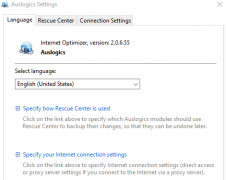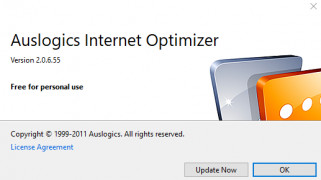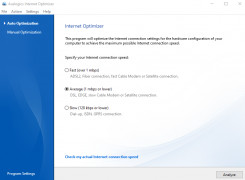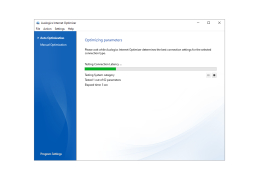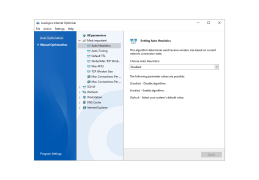
Auslogics Internet Optimizer
A installation to modify about 80+ network and browser configurations
Operating system: Windows
Publisher: Auslogics Software Pty Ltd
Release : Auslogics Internet Optimizer 2.0.6.55
Antivirus check: passed
I installed this software, and the first thing I notice is that it links me to a third party website, speedtest.net, to test my internet speed. But once I clicked "Analyze," I can see that seems to have its own speed testers. My review is that it does seem like a useful utility. The Analyze report is displayed in this small pop-up window, almost looking like Windows Task Manager, but simpler. It has some recommendations about things that is doesn't explain why. Like "Socket Receive Buffer Length, is 8 kbytes, but it recommends 23kbytes. And ECN Capability says my windows machine is Enabled, but Auslogics recommends to Disable it. IT has two main choices, Auto Optimization or Manual. Because there are about 30 items it wasn’t to change, I'm going to click the manual.
The other menu option is to click the Program Settings. Here is where I can apply a Rescue Center, I think, to back up any changes made.
It also has a button Back to General Settings, but what General? Auslogics definition of "General" or my systems original "General" configuration, or the latest windows default "General" settings. This is confusing. If I explore Manual settings, then click back into Auto Optimization. It seems to lose all those 30 recommendations. I think this software will take a little while to learn unless I am a programmer. I do have programming experience, but I am not a programmer. The menu does have a restore Default settings, but it's confusing if this is really my settings, or what it thinks Default is. It also recommends to Disable PIPv6 over IPv4. Currently, my system has this enabled. This seems like it could make things faster. But strangely, it recommends a HUGE suspicious change of TCP Window size from my setting of 16 kbytes to 24,820 kbytes. To me, this is strange without an explanation or a link to MSDN or Microsoft socket terms. It seems strange, these recommendations, like increasing the DNS Cache timeout and server info timeout. Why would I want to make my computer wait even longer for timeouts? The software's interface is bland, but for a scanning tool, I think I like it.
Once in the Manual mode, a huge tree node of about 100 plus items DOES define what these settings are. Like ECN Capability. And it seems to allow me to set what my Default is, which answers my question. So it appears it doesn't actually save my original default settings but does allow me to save them individually. The Auslogic's explanations seem brief but helpful. However, still, no link to a trusted Microsoft source or MSDN website. It's hard to see which settings are for my "Browser," like the software says it can configure. Which browser? The underlying Mozilla? The Microsoft Edge, Firefox? This software has the thoroughness in technicality but lacks the assurance. If it had a testing or scenario explanation, it would make the assurance better. Like some Wireshark actual tests, or geographic tests, like how many nodes do I have? Does it test my router? My hub?
It seems to make a desktop system work better by being more efficient, disabling unnecessary settings or increasing other configurationsFeatures:
-
Using the Auto mode, it scans the system and compiles a list from 80+ settings Automatically ready to change with one click
-
Allows the same changes to be toggled independently using the Manual mode
-
Provides explanations of each configuration within the tool itself, to better know what I am changing
-
Comes with a built-in "Rescue Center" allowing me to backup or revert to any certain settings
Overall, these auto heuristics are quite detailed and seem like big changes, without assurance that they can easily be reverted back to what I had. It is easy to quickly see the 88 configurations to change, but only when in Manual mode.
PROS
Enhances internet performance significantly.
Offers customizable optimization options.
CONS
May install additional unwanted programs.
Help and support options lacking.


